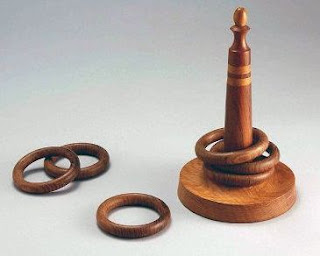14 June 2022
What Did Horseshoes Look Like?
13 June 2022
Quoits
Those who subscribe to the Greco-Roman origin use it as a basis for quoits coming to Britain during the Roman occupation. The game of quoits ("coiting") in England during the reign of Edward III, and again during the reign of his successor, Richard II, was outlawed in favor of pastimes such as archery, which would translate to readiness in battle. This was duplicated in the Statutes of Kilkenny (see here and here) by Edward's son, Lionel of Antwerp, in his rôle as viceroy of Ireland.
(Ironically, quoits was referred to as "manly and healthy amusements" in 1836 in a Washington, DC, advertisement for the available amusements at a nearby coffee house.)
The similarity between quoits and the game of horseshoes suggests that the game might have started with people idling their time by throwing spare horseshoes at a stake or peg. That assumes, however, that "horse shoes" in the past were the ring- or U-shaped pieces of metal they are now.
And that is something worth looking into in more detail.
21 January 2013
Electrical Engineers
Saint Eligius (or Eloi, or Eloy) was born about 588 near Limoges, France. His father recognized skill in him, and sent him as a young man to a noted goldsmith to learn a trade. He became so good at it that he was commissioned by Clothar II, King of the Franks, to make a golden throne decorated with precious stones. With the materials he was given, he made the throne with material left over ("enough for two" it was said). Since it was not unknown for artisans to use less than they were given and hide away the excess for their own wealth, Eligius' honesty in designing the throne was noteworthy.
On the death of Clothar, his son Dagobert became King of the Franks. Dagobert (c.603 - 19 January 639) appointed Eligius his chief councilor. Dagobert is considered the last king of the Merovingian line to wield any real power on his own. After him came the weak kings that allowed the Mayors of the Palace to establish the Carolingian dynasty.
Dagobert and Eligius became very close, and it is said that Dagobert relied in Eligius heavily—sometimes exclusively—for advice. With Dagobert's help (i.e., money) Eligius established several monasteries, purchased and freed slaves brought into Marseilles, sent servants to cut down the bodies of hanged criminals and give them decent burial.
In 642, the goldsmith and councilor became a cleric when Eligius was made Bishop of Noyon. He undertook to convert the non-Christians in his diocese, and preached against simony in the church. Some of his writings have survived.
But it was the legends after his death that gave him his current reputation. Of course he is the patron of goldsmiths and craftsmen, and is often depicted holding a bishop's crozier in one hand and a hammer in the other. By extension, he is the patron of all metalworkers, which would include blacksmiths. Over time, the skills of the blacksmith evolved into the skills of mechanical engineers. But that is not to say that Eligius was not a problem-solver on a par with engineers. The legend tells that he was once faced with a horse that refused to cooperate with being shod. Eligius cut off the leg that needed shoeing, put a horseshoe on the detached hoof, then re-attached the leg to the horse! The Corps of Royal Electrical and Mechanical Engineers of the British Army have taken Eligius for their patron saint.


